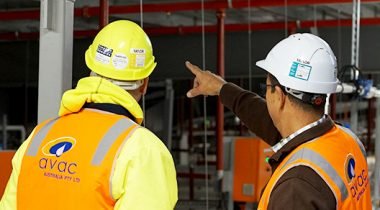Vacuum drainage systems for grey water utilise vacuum pressure for the collection, conveyance and disposal of grey water through a piping network that can be routed horizontally or even run uphill.
Components
- Waste Collection Points (e.g. wash-down water drains in stadiums, basins, mop basins, shower drains) are connected to the main piping network via a vacuum interface valve which opens to allow waste to pass from the fixture in to the piping network
- The Vacuum Drainage Piping Network is a closed piping network which is maintained under continuous vacuum pressure and is usually either standard pressure rated PVC, HDPE or stainless steel. It consists of ‘risers’ or ‘droppers’ which transport waste vertically from the point of origin to horizontal mains and branches leading to the Vac Centre.
- The Vacuum Generating Station (‘Vac Centre’) includes the vacuum pumps that create a vacuum in the piping network, storage tanks that collect and discharge the waste into the sewer system and in some cases sewer discharge pumps. Avac offer a range of pre-fabricated Vac Centres (The Championship Series) or alternatively can design and size a customised system to suit specific project needs.
Benefits
Flexibility In Design & Layout Of Collection Points & Equipment
Vacuum grey water systems allow collection of waste from seating platforms in stadiums without impeding the view of the lower seats as traditional stormwater drains do. The piping can run under the platform horizontally or can even run uphill till it is clear of the spectators.
Reduced Construction Costs
Labour and material costs are reduced since the installation is generally above ground and smaller diameter piping is used. On renovation work, the savings can be substantial depending on the size of the existing facility and the length and depth of trenching required for gravity waste pipe tie-in.
Easily Retrofitted
Vacuum drainage systems allow existing buildings with limited drainage to be developed for use when traditional trenching and underground piping upgrades are cost prohibitive because of site or structural conditions such as post tension slab, bed rock, asbestos, high water tables, etc.







